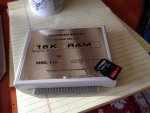We moved recently, and whenever that happens you get to find stuff you haven't seen in a while. Here's one; a 16K RAM expansion module that I probably paid $200 for. Contrast that with a 32G SD card today for $15.
So, here's the useless facts for today;
2,000,000 times the memory for 7% of the cost.
For the same money you now get 426G
By volume you 8.17 Terabits

So, here's the useless facts for today;
2,000,000 times the memory for 7% of the cost.
For the same money you now get 426G
By volume you 8.17 Terabits


